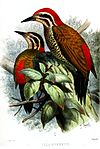Dinopium
| Flamebacks | |
|---|---|

| |
| Common flameback (Dinopium javanense) | |
| Scientific classification | |
| Domain: | Eukaryota |
| Kingdom: | Animalia |
| Phylum: | Chordata |
| Class: | Aves |
| Order: | Piciformes |
| Family: | Picidae |
| Tribe: | Picini |
| Genus: | Dinopium Rafinesque, 1814 |
| Type species | |
| Dinopium (Picoides) erythronotus[1] Rafinesque, 1814
| |
| Species | |
|
see text | |
Dinopium is a genus of birds in the woodpecker family Picidae. The species are found in South and Southeast Asia.
The genus was introduced by the French polymath Constantine Samuel Rafinesque in 1814 to accommodate the common flameback (Dinopium javanense).[2][3] The name combines the Classical Greek deinos meaning "mighty" or "huge" and ōps/ōpos meaning "appearance".[4]
A large phylogenetic study of the woodpecker family Picidae published in 2017 found that the genus was paraphyletic. The olive-backed woodpecker (Dinopium rafflesii) is more closely related to the pale-headed woodpecker (Gecinulus grantia) than it is to other members of the genus Dinopium.[5]
Species
[edit]As presently constituted, the genus contains the following 5 species:[6]
| Image | Scientific name | Common Name | Distribution |
|---|---|---|---|
 |
Dinopium shorii | Himalayan flameback | Bangladesh, Bhutan, India, Myanmar, and Nepal |
 |
Dinopium javanense | Common flameback | Bangladesh, Brunei, Cambodia, China, India, Indonesia, Laos, Malaysia, Myanmar, Singapore, Thailand, and Vietnam |

|
Dinopium everetti | Spot-throated flameback | island of Palawan in the Philippines. |
 |
Dinopium benghalense | Black-rumped flameback | Pakistan, India south of the Himalayas and east till the western Assam valley and Meghalaya, Bangladesh and Sri Lanka |

|
Dinopium psarodes | Red-backed flameback | Sri Lanka |
References
[edit]- ^ "Picidae". aviansystematics.org. The Trust for Avian Systematics. Retrieved 2023-07-26.
- ^ Rafinesque, Constantine Samuel (1814). Principes Fondamentaux de Somiologie (in French). Palerme. Inside front cover.
- ^ Peters, James Lee, ed. (1948). Check-List of Birds of the World. Vol. 6. Cambridge, Massachusetts: Harvard University Press. p. 143.
- ^ Jobling, James A. (2010). The Helm Dictionary of Scientific Bird Names. London: Christopher Helm. p. 136. ISBN 978-1-4081-2501-4.
- ^ Shakya, S.B.; Fuchs, J.; Pons, J.-M.; Sheldon, F.H. (2017). "Tapping the woodpecker tree for evolutionary insight". Molecular Phylogenetics and Evolution. 116: 182–191. Bibcode:2017MolPE.116..182S. doi:10.1016/j.ympev.2017.09.005. PMID 28890006.
- ^ Gill, Frank; Donsker, David; Rasmussen, Pamela, eds. (2020). "Woodpeckers". IOC World Bird List Version 10.1. International Ornithologists' Union. Retrieved 17 May 2020.








